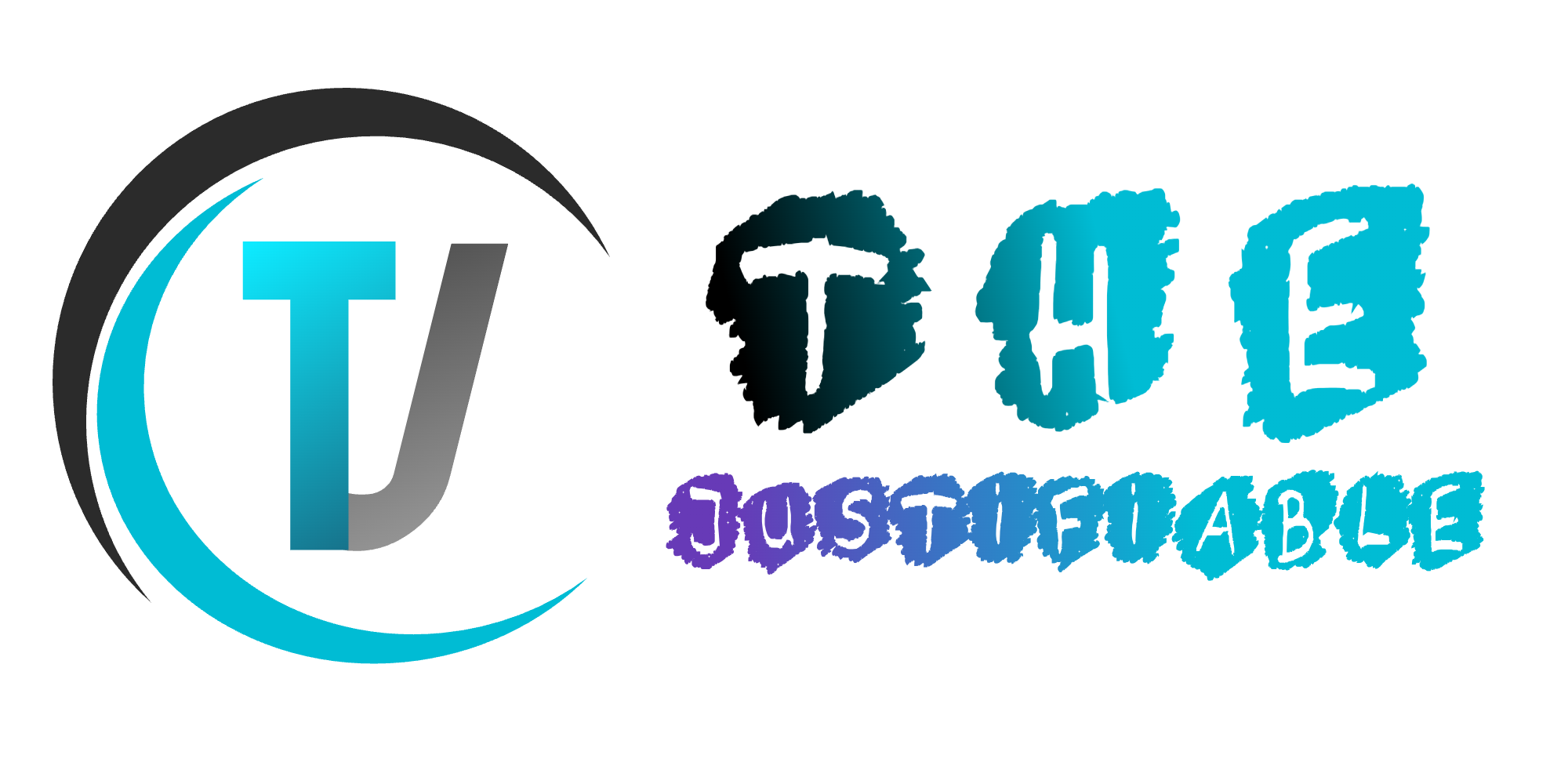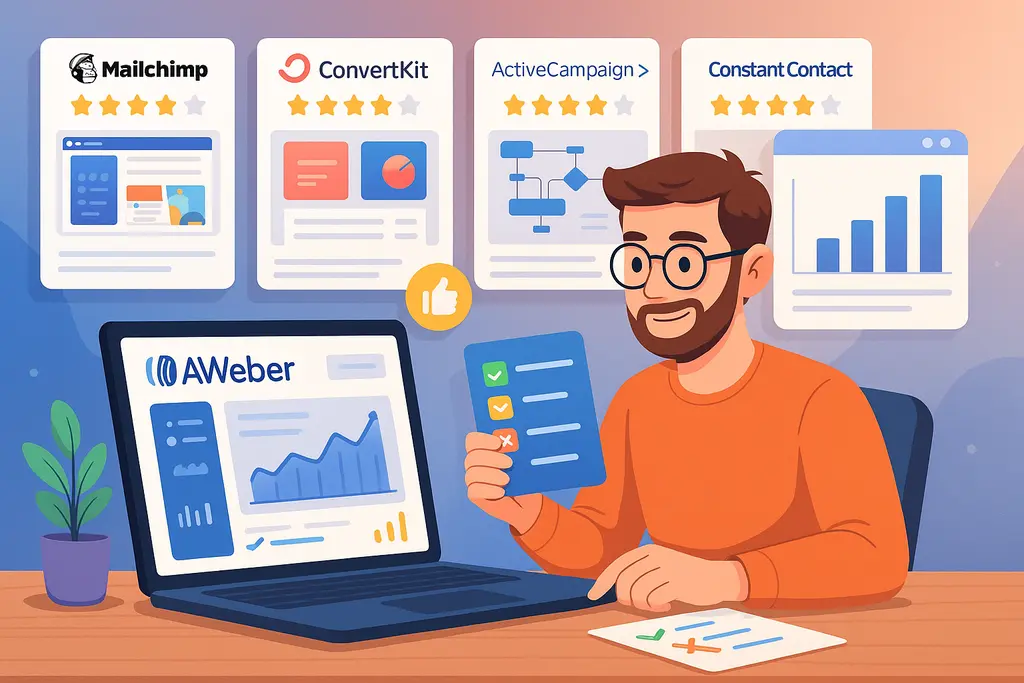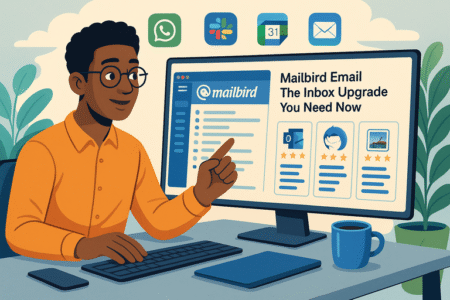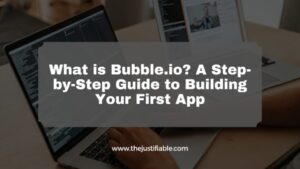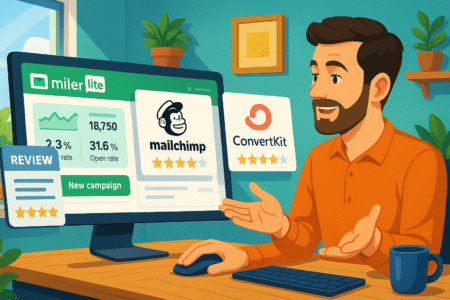Table of Contents
Aweber reviews often spark the same question: is this platform still worth using when there are so many other email marketing tools out there?
If you’ve ever wondered how Aweber stacks up against alternatives, you’re not alone. Should you invest in Aweber for its simplicity and automation features, or do competitors offer better value for your money?
In this article, we’ll break down Aweber’s strengths and weaknesses, compare it directly with the top alternatives, and help you figure out which platform truly fits your business needs.
What Makes Aweber Stand Out Among Email Marketing Tools
Aweber has been around for a long time, which makes people curious whether it’s still keeping up with modern email marketing demands.
From my experience, it stands out in a few important ways that make it appealing for both beginners and small businesses.
Easy-To-Use Interface Designed for Beginners
One of Aweber’s strongest points is how easy it is to get started. The dashboard is clean, and the learning curve is gentle compared to more advanced tools like ActiveCampaign.
If you’ve never created a campaign before, you can literally log in, click “Create a Message,” and use their drag-and-drop editor without needing design skills.
I’ve noticed this matters most for people who don’t have time to learn complicated workflows. You can move blocks of text, images, or buttons around like Lego pieces.
It’s intuitive enough that someone could set up their first newsletter in less than an hour. That’s not always the case with competitors, which often require tutorials before you feel comfortable.
Robust Email Templates That Save Time
Aweber offers hundreds of pre-designed templates, and this is where it becomes a time-saver. Instead of starting with a blank email, you can choose from layouts built for product launches, holiday promotions, or simple newsletters.
What I really like is that each template is fully customizable—change the colors, swap images, and adjust fonts. For small businesses that can’t afford a designer, this feels like an upgrade. Mailchimp also has a large template lbrary, but Aweber’s are cleaner and often require fewer tweaks to look professional right away.
A quick tip: If you want to maintain consistent branding, save your edited templates as “Favorites” inside your dashboard. This way, every new campaign is just a couple of clicks away from being ready.
Automation Features That Improve Campaign Efficiency
Email automation is where Aweber has caught up in recent years. You can set up sequences for welcome emails, product follow-ups, or abandoned cart reminders. From the dashboard, you’d go to “Campaigns” and select “Create a Campaign,” then build a sequence triggered by subscriber actions.
This saves hours of manual work because once it’s live, your emails go out automatically based on behavior.
For example, if someone signs up for your free guide, Aweber can automatically send them a 5-part nurture series. That’s the kind of system that builds trust with subscribers while you focus on your business.
While competitors like ConvertKit are known for automation, Aweber has stepped up its game, making this feature accessible without the steep learning curve.
Analytics and Reporting for Smarter Decisions
Running email campaigns without data is like driving with your eyes closed. Aweber’s analytics panel shows you key metrics such as open rates, click-through rates, and subscriber growth. What I appreciate is how straightforward it is—you don’t need to be a data analyst to understand what’s working.
For example, you can quickly see which subject lines perform best and then reuse that style. You can also track which links inside your emails get the most clicks. That’s actionable information you can apply immediately.
The one thing to note is that competitors like ActiveCampaign and GetResponse offer deeper analytics, especially when tied into sales funnels. But for small businesses, Aweber’s reports hit the sweet spot of being detailed enough without being overwhelming.
Aweber Pricing Plans Compared To Competitors
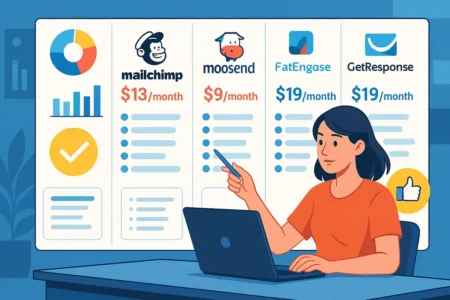
Pricing is usually the deciding factor for most people, and Aweber sits in an interesting position between affordable starter tools and high-powered, expensive platforms.
Affordable Starter Plan With Key Features Included
Aweber’s Lite plan starts at $12.50/month (when billed annually), which gives you one email list, three landing pages, and a limited number of automations. For someone just starting out with fewer than 500 subscribers, this covers the basics without breaking the bank.
The Plus plan, priced at $20/month annually, is where most users land. It unlocks unlimited email lists, advanced automation, custom segments, and 24/7 support. In my view, this is the sweet spot if you’re serious about growing an email strategy but don’t want enterprise-level costs.
There’s also a “Done For You” setup option at the same price, though it comes with a one-time setup fee. That’s helpful if you want someone else to build your email system quickly.
Value Of Aweber’s Free Plan Versus Mailchimp And Moosend
Aweber does have a free option for up to 500 subscribers, but it’s more limited compared to competitors. You’ll deal with Aweber branding on your emails, and you won’t have access to advanced features like automation.
Mailchimp’s free plan is slightly more generous for small users, while Moosend offers competitive free tiers with automation included. That means if you’re only experimenting, those tools may feel like a better fit.
But once you’re ready to scale, Aweber’s Plus plan often ends up being more practical because you get unlimited landing pages and email lists, which Mailchimp restricts.
Scalability Of Pricing For Growing Businesses
One thing worth pointing out is how Aweber’s pricing scales as your list grows. If you go from 500 to 2,500 subscribers, the monthly cost rises, and it continues climbing as your audience expands. This is common in the email marketing space, but it’s something to budget for if you expect fast growth.
The advantage here is that Aweber doesn’t lock important features behind higher tiers. You’ll still get access to the same core tools—you’re just paying for the volume of subscribers. That feels fairer than platforms that keep advanced features only for premium users.
Extra Costs To Watch Out For In Aweber
While Aweber’s pricing is transparent, there are some extra costs to keep in mind. The “Done For You” service has a one-time setup fee, which is currently discounted but still an added expense.
Also, while Aweber does remove its branding in the paid plans, the free version forces you to carry their logo, which can look unprofessional.
Another thing I’ve seen users overlook is transaction fees on sales made through landing pages. They’re lower than some competitors, but still worth factoring in if you plan to sell digital products directly.
If you’re comparing Aweber with Mailchimp or ConvertKit, it’s important to look beyond just the monthly fee and think about the hidden costs like branding, setup help, and transaction fees.
Aweber vs Mailchimp: Which Platform Delivers More Value
Aweber reviews often circle back to one big question: does it actually beat Mailchimp when it comes to features and pricing?
These two platforms get compared constantly, and while they look similar on the surface, they serve slightly different types of users.
Differences In Template Customization Options
Both Aweber and Mailchimp give you a big library of templates, but the way they handle customization feels different in practice.
- Aweber’s drag-and-drop editor is lightweight and straightforward. If you’re in the dashboard and click Messages > Create a Message, you’ll see blocks for text, buttons, and images you can just move around. I’ve found that even people who “aren’t design people” can produce a polished newsletter within minutes.
- Mailchimp, on the other hand, offers more advanced design flexibility. You can tweak padding, spacing, and style in a way that gives you pixel-perfect control. That’s powerful, but it can also slow you down if you just want something simple and ready to send.
In my experience, Aweber wins for speed and ease, while Mailchimp edges ahead if you’re a perfectionist about brand details.
Comparing Automation And Segmentation Capabilities
Automation is where Mailchimp and Aweber take very different approaches.
- In Aweber, automations live under Campaigns. You can build a simple flow like: “When subscriber joins list → Send welcome email → Wait 2 days → Send follow-up.” It’s enough for most small businesses running lead magnets, nurture sequences, or product promotions.
- Mailchimp takes it deeper with behavioral targeting, retargeting ads, and multi-step workflows. You can, for example, send an email only to people who clicked a certain product link in your last campaign.
That being said, I believe Aweber has a gentler learning curve. If you’ve never touched automations before, Mailchimp can feel overwhelming, while Aweber feels like training wheels that still get you to your destination.
Ease Of Use For Beginners And Non-Technical Teams
This is where Aweber reviews consistently score higher than Mailchimp. The interface is less cluttered, and the onboarding tutorials walk you through the basics.
I’ve seen clients get stuck in Mailchimp simply trying to understand where lists, tags, and audiences fit together. Aweber takes a simpler “list and segment” approach that’s easier to grasp. For small teams or solo founders without a tech person, this simplicity is worth a lot.
Think of it like this: Mailchimp is a Swiss army knife with hidden tools you’ll spend hours figuring out. Aweber is a clean toolbox with exactly what you need labeled clearly.
Pricing Flexibility Between Aweber And Mailchimp
Pricing is where the comparison gets tricky.
- Mailchimp’s free plan looks attractive on the surface, but once you need automation or advanced segmentation, you’ll quickly get pushed into a higher tier.
- Aweber’s free plan is more limited but their Plus plan at $20/month (for up to 500 subscribers) unlocks unlimited lists, automations, and landing pages. Mailchimp charges more for those same capabilities.
Here’s a quick side-by-side snapshot for 500 subscribers:
| Feature | Aweber Plus ($20/mo) | Mailchimp Essentials ($13/mo) | Mailchimp Standard ($20/mo) |
| Unlimited lists | ✅ Yes | ❌ No | ✅ Yes |
| Automation sequences | ✅ Yes | ❌ Limited | ✅ Advanced |
| Templates | ✅ 600+ | ✅ 100+ | ✅ 100+ |
| 24/7 support | ✅ Yes | ❌ Email only | ❌ Email only |
For small businesses, I recommend Aweber if you’re ready to grow beyond the free tier, because the feature set scales more fairly without locking essentials behind higher prices.
Aweber vs Kit (formerly ConvertKit): Which Is Best For Creators
While Mailchimp aims broadly at small businesses, Kit was built specifically with creators—bloggers, podcasters, coaches, and course builders—in mind.
Aweber reviews often compare these two because they overlap on automation and subscriber management, but the feel of the platforms is quite different.
Email Automation For Content Creators And Bloggers
Kit (formerly ConvertKit) shines when it comes to automation. From the dashboard, you can map out visual automations with drag-and-drop logic.
For example: “If subscriber clicks webinar link → Tag as Interested → Send sales funnel sequence.” That’s extremely powerful for content creators who need to nurture leads differently based on engagement.
Aweber, meanwhile, makes automation accessible without being overwhelming. You can set up sequences quickly under Campaigns, but they’re more linear. Think of it as a straight path versus Kit’s branching trees.
If you’re a blogger who just wants a simple welcome series, Aweber is enough. But if you run multiple products and want deep behavioral targeting, Kit pulls ahead.
Comparing Subscriber Tagging And Segmentation Tools
Tagging and segmentation is the backbone of personalization.
- Aweber lets you segment subscribers by actions like opening emails or clicking links. You can also create custom segments, which works well for basic personalization.
- Kit makes tagging central to the whole system. Instead of just “lists,” you can tag people based on virtually anything—purchases, downloads, link clicks, and more.
For creators with diverse content streams (e.g., free newsletter + paid course + coaching program), Kit gives more flexibility. Aweber keeps it simpler, which is less flexible but less confusing.
Ease Of Monetization Features Like Paid Newsletters
This is an area where Kit really built for creators. They have a built-in feature called Kit Commerce, where you can sell digital products or subscriptions directly from your emails. If you run a paid newsletter, you can charge subscribers without needing a third-party integration.
Aweber also allows selling through landing pages with Stripe integration, but it’s more of an add-on than a native system. It works, but it doesn’t feel as seamless as Kit’s monetization features.
If your goal is to monetize content directly (like selling a mini-course straight from your email list), I’d suggest Kit. If your focus is email campaigns with occasional sales links, Aweber works fine.
Pricing And Long-Term Value For Solo Entrepreneurs
This is where things get interesting.
- Kit’s free plan covers up to 1,000 subscribers but with limited automation. Their paid plans start at $29/month for automation and tagging.
- Aweber’s Plus plan is cheaper at $20/month for up to 500 subscribers, and it includes unlimited landing pages and automations right away.
Here’s a quick comparison for a solo creator just starting out:
| Feature | Aweber Plus ($20/mo) | Kit Creator ($29/mo) |
| Subscriber limit | 500 | 1,000 |
| Automation included | ✅ Yes | ✅ Yes |
| Landing pages | ✅ Unlimited | ✅ Unlimited |
| Paid newsletters | ❌ Requires Stripe | ✅ Built-in |
| Pricing as you scale | Moderate increase | Steeper increase |
From what I’ve seen, Aweber is the better deal for someone testing the waters or growing slowly. Kit becomes more valuable once you’re actively monetizing and need advanced segmentation.
Aweber vs ActiveCampaign: Which Is Better For Automation
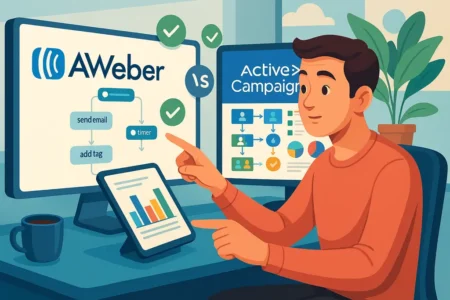
When people read aweber reviews, automation always comes up. This is exactly where ActiveCampaign gets its reputation as the heavyweight.
But does that mean Aweber can’t hold its own? Let’s break it down.
Depth Of Automation Workflows In Both Platforms
If automation is the engine of email marketing, then ActiveCampaign is like a Formula 1 car, while Aweber is more like a reliable SUV. Both will get you to your destination, but one is built for speed and advanced control.
- Aweber’s automation flows (found under Campaigns) are straightforward. You can set a trigger like “subscriber joins list” and build sequences with delays, conditions, or follow-up actions. It works perfectly for welcome series, drip campaigns, and abandoned cart reminders.
- ActiveCampaign takes this to another level. You can branch workflows based on hundreds of conditions — location, purchase history, website activity, even predictive actions. For example: “If a subscriber visits the pricing page twice in a week, send a targeted offer.”
For someone running a coaching business or an online shop, Aweber’s automation is more than enough. If you’re managing a complex sales funnel with multiple buyer personas, ActiveCampaign is the powerhouse.
CRM Integration And Advanced Sales Features
This is the key difference. Aweber is focused on being an email marketing platform. ActiveCampaign is closer to a hybrid between email + CRM (Customer Relationship Management).
- Aweber integrates with tools like Shopify, Stripe, and WordPress to support transactions and subscriber management. It’s email-first, not sales-first.
- ActiveCampaign has a full CRM built in. You can manage pipelines, assign tasks to sales reps, and see a subscriber’s entire journey from lead to conversion.
I’d suggest ActiveCampaign if your business has a sales team or if you’re tracking deals with high touchpoints. For a solopreneur or small team, that level of complexity might just feel like unnecessary overhead.
Differences In Customer Support And Onboarding
One of the things that often gets overlooked in aweber reviews is support. Aweber is known for having 24/7 live support via chat, email, and even phone (a rarity). I’ve personally found their team approachable and quick to respond, even for basic “how do I create a tag” type questions.
ActiveCampaign has excellent support too, but the onboarding can feel heavier because of the sheer depth of features. They do offer one-on-one training calls on higher plans, but for a beginner, it can be intimidating.
If you value hand-holding while you get started, Aweber makes it easier. If you’re a tech-savvy marketer ready to dive into complex automation, ActiveCampaign’s resources will keep you busy.
Price Gaps Between Aweber And ActiveCampaign
Pricing is where these two really diverge.
- Aweber Plus starts at $20/month for up to 500 subscribers with full automation unlocked.
- ActiveCampaign starts at $$49/month for the “Plus” plan with automation, but the cost scales quickly as your list grows. Add CRM features, and you’re paying significantly more.
Here’s a quick look side by side:
| Feature | Aweber Plus ($20/mo) | ActiveCampaign Plus ($49/mo) |
| Automation included | ✅ Yes | ✅ Yes |
| CRM features | ❌ No | ✅ Yes |
| 24/7 support | ✅ Yes | ❌ Limited |
| Price scaling | Moderate | Steep |
If automation depth is non-negotiable, ActiveCampaign is the obvious choice. But for balanced features and predictable pricing, I’d lean Aweber.
Aweber vs GetResponse: Which Offers More Marketing Tools
Another question that comes up in aweber reviews is whether GetResponse offers more bang for your buck. The truth is, GetResponse markets itself as an “all-in-one” solution, while Aweber keeps its scope narrower.
Comparing Landing Page And Funnel Building Tools
Both Aweber and GetResponse let you build landing pages, but the differences are clear.
- Aweber’s landing page builder is simple. You can pick a template, add forms, and connect it to your list. From the dashboard, go to Landing Pages > Create a Landing Page and you’ll be up and running in minutes. It’s effective for quick lead magnets or opt-ins.
- GetResponse goes further with a funnel builder. You can map out the full process: opt-in page → email sequence → sales page → checkout. It feels more like ClickFunnels baked into an email platform.
If you’re running straightforward campaigns, Aweber’s pages are enough. But if you want multi-step funnels tied to sales, GetResponse has the edge.
Webinar Hosting Capabilities In GetResponse
This is one of GetResponse’s unique features. You can host webinars directly within the platform, integrate sign-ups with your lists, and automate follow-ups. Aweber doesn’t offer this natively—you’d need to integrate a separate tool like Zoom or WebinarJam.
If webinars are a big part of your marketing (say, you’re selling a course or software), GetResponse makes life easier. For businesses that don’t rely on webinars, Aweber’s simpler approach keeps costs lower.
Email Template Quality And Variety
Both tools provide ready-to-use templates, but the experience feels different.
- Aweber’s library of 600+ templates is diverse, and the drag-and-drop editor is easy for beginners. It feels polished out of the box.
- GetResponse templates are solid but focus more on flexibility. They give you more freedom to adjust layouts, which is great if you want pixel-perfect branding but can slow down campaign creation.
I’d argue Aweber templates are better suited for someone who wants speed, while GetResponse templates reward those who like tinkering.
Scalability For Small Businesses Vs Larger Brands
This is where the decision often gets made.
- Aweber is ideal for small businesses, freelancers, and creators who want to manage lists, send campaigns, and run basic automation without extra layers of complexity.
- GetResponse scales into a full marketing suite for larger brands. Beyond email, you’re getting funnels, webinars, and advanced analytics. Of course, that means paying more as you add subscribers and tools.
Here’s a side-by-side to make it clear:
| Feature | Aweber Plus ($20/mo) | GetResponse Starter ($13.12/mo) |
| Landing pages | ✅ Unlimited | ✅ Unlimited |
| Funnel builder | ❌ No | ✅ Yes |
| Webinars | ❌ No | ✅ Yes |
| Template variety | ✅ 600+ | ✅ 500+ |
| Scalability focus | Small businesses | Mid-size to large brands |
If you’re a solo entrepreneur, Aweber is likely the leaner and friendlier option. If you’re running multi-channel campaigns with funnels and webinars baked in, GetResponse makes more sense.
Here’s my take: Aweber feels like a trusted “email-first” tool that keeps things simple and affordable, while ActiveCampaign and GetResponse aim for complexity and breadth. Aweber reviews highlight exactly this contrast — it’s not always about who has more features, but who fits your style of working best.
Aweber vs Constant Contact: Which Is More User-Friendly
When people read aweber reviews, a common comparison is with Constant Contact. Both platforms market themselves as easy-to-use, beginner-friendly tools — but their strengths differ once you dig deeper.
Ease Of Learning Curve For Non-Tech Users
Constant Contact is known for simplicity. You log in, choose a template, type your message, and hit send. For someone brand new to email marketing, it feels like following a recipe card.
Aweber, though, balances simplicity with flexibility. From the dashboard, you’ll see clear tabs like Messages, Subscribers, and Landing Pages. I’ve noticed new users appreciate the clarity — it doesn’t feel cluttered.
Here’s my personal take: Constant Contact is a little easier on day one, but Aweber gives you more room to grow without needing to switch platforms later.
Comparing Event Management And Marketing Features
One area where Constant Contact stands out is event management. You can create invites, track RSVPs, and manage registrations right inside the platform. For nonprofits or community groups running regular events, this is a lifesaver.
Aweber doesn’t have built-in event tools, but it integrates smoothly with Eventbrite and other services.
Instead, Aweber focuses more on automation, segmentation, and landing pages. If events are your main marketing activity, Constant Contact might make sense. If you want automation-driven campaigns, Aweber is stronger.
Customer Support Availability And Responsiveness
Support can make or break your experience. Aweber offers 24/7 live chat, email, and even phone support. I’ve called their team myself, and the fact you can speak with a real human without waiting days is rare in this industry.
Constant Contact offers support too, but response times can be slower depending on the channel. For ongoing hand-holding, I believe Aweber has the edge.
Cost Effectiveness For Small Business Budgets
Constant Contact pricing starts slightly higher and often charges extra for features like automation. Aweber’s Plus plan at $20/month includes automation, unlimited lists, and landing pages without those add-on costs.
Here’s a quick snapshot for comparison:
| Feature | Aweber Plus ($20/mo) | Constant Contact Core ($12/mo) |
| Automation | ✅ Included | ❌ Limited |
| Event management | ❌ No | ✅ Yes |
| Support | ✅ 24/7 + phone | ✅ Yes, limited hours |
| Landing pages | ✅ Unlimited | ✅ Limited |
For most small businesses, Aweber ends up being more cost-effective unless event features are critical.
Strengths And Weaknesses Of Aweber Reviews Summarized
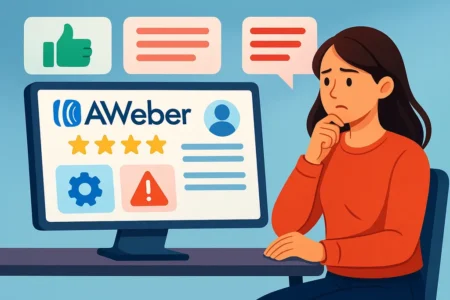
To wrap up comparisons, it’s worth stepping back and looking at what aweber reviews consistently highlight as strengths and weaknesses.
Main Strengths That Make Aweber A Reliable Choice
- Extremely beginner-friendly interface
- Huge template library (over 600 designs)
- Solid automation features without a steep learning curve
- Affordable pricing compared to advanced platforms
- 24/7 live support, including phone help
I recommend Aweber for anyone who wants a dependable platform that “just works” without needing advanced technical skills.
Common Weaknesses Reported In Aweber Reviews
- The free plan is restrictive compared to Mailchimp or Moosend
- Branding on free plan emails can look unprofessional
- Automation, while good, isn’t as deep as Kit or ActiveCampaign
- Limited advanced marketing features (e.g., webinars, funnels)
These aren’t deal-breakers for small businesses, but they do matter if you’re running a large, complex marketing operation.
Best Fit Businesses That Benefit From Aweber
- Solo entrepreneurs who need quick setup and simple workflows
- Small e-commerce shops using Shopify or WooCommerce integrations
- Coaches, bloggers, and course creators who value ease of use
- Local businesses that want a dependable way to stay in touch with customers
Situations Where Aweber May Not Be Ideal
- Large enterprises that need advanced CRM features
- Marketers running multi-channel funnels with webinars and paid ads
- Businesses that want free tools to scale before paying
- Teams needing advanced branching automation logic
If you’re in those categories, tools like ActiveCampaign, GetResponse, or Kit may serve you better.
How To Decide If Aweber Or An Alternative Is Right For You
At this point, you’ve seen how Aweber stacks up against Mailchimp, Kit, ActiveCampaign, GetResponse, and Constant Contact. The real decision comes down to your priorities.
Identify Your Email Marketing Priorities And Goals
Start by asking yourself: what matters most? Is it ease of use, automation depth, event features, or cost? For example:
- If simplicity is key → Aweber or Constant Contact.
- If automation is critical → ActiveCampaign or Kit.
- If webinars are central → GetResponse.
Compare Features Based On Business Stage And Needs
Where your business is today affects your choice. A small solopreneur probably doesn’t need ActiveCampaign’s CRM. But a growing sales team might find Aweber too light.
I advise making a simple checklist: Must-have features, nice-to-have features, and deal-breakers. Then match each platform to that list.
Consider Long-Term Pricing And Scalability
Don’t just look at the starter price. Check what happens when you hit 2,500 or 10,000 subscribers. Some platforms jump in price quickly, while others scale more gradually. Aweber scales moderately, which feels predictable.
Test Free Trials To See Which Platform Fits Best
Almost all these tools offer free trials or free plans. The best way to decide is hands-on:
- Sign up for Aweber’s 14-day free trial.
- Create a campaign in the dashboard.
- Do the same in Mailchimp, ConvertKit, or whichever competitor you’re considering.
- Compare how each feels to you in practice.
Here’s a pro tip to close: Aweber may not always win on having the most features, but it consistently wins on usability and support. If your main priority is running clean, effective campaigns without overcomplicating things, Aweber is a solid long-term partner.

